It looks like you're using an Ad Blocker.
Please white-list or disable AboveTopSecret.com in your ad-blocking tool.
Thank you.
Some features of ATS will be disabled while you continue to use an ad-blocker.
share:
Are we all really advanced crystal beings?
In essence, postulation that there is an intelligent mechanism that is behind everything we see and experience.
As such, it is peering into the eye of God, for what ever God really is.
Not in a religious sense, but more importantly in understanding the
incredible granularity that exists in more fundamental processes that relate to the
formation of life as we understand it.
If we step back and look at what nature has created, in order for life to even start,
we need look no further than crystals.
The fundamental structures of atoms and molecules themselves, show incredible intent as
well as evolution..
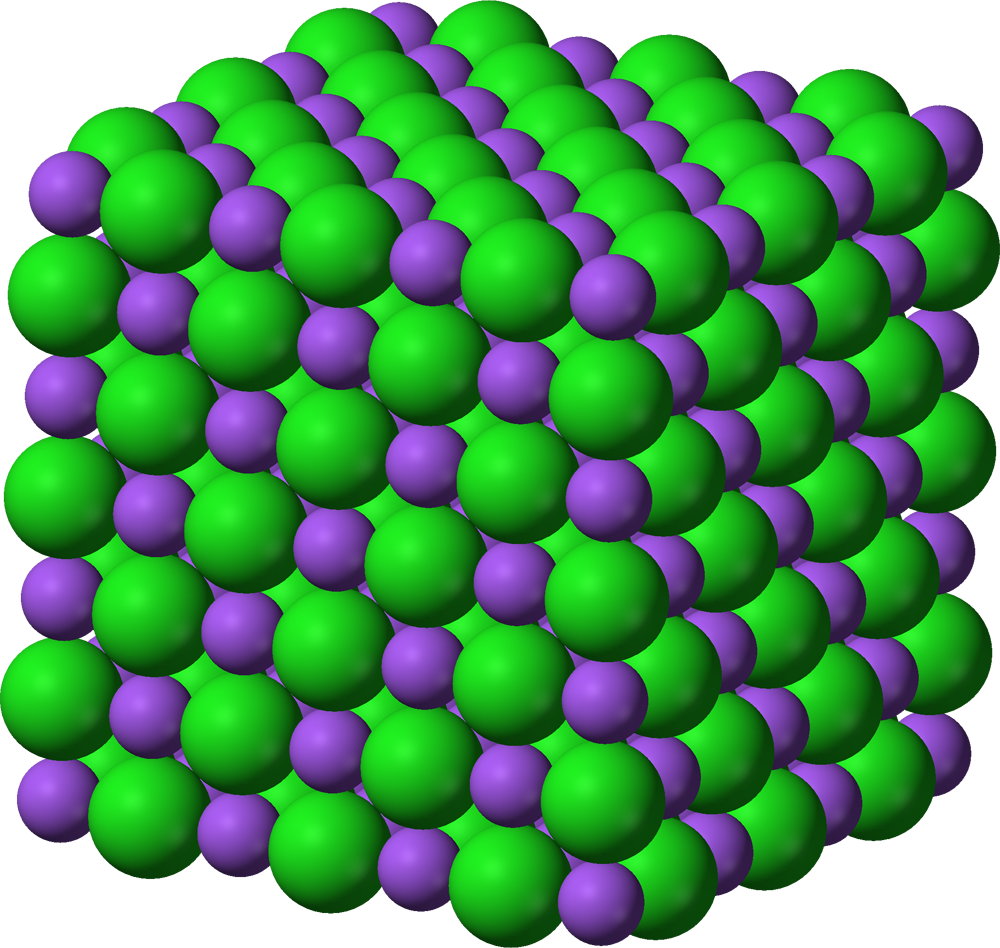
This is a molecule of sodium chloride. Like it's primitive state, salt crystals (and
all crystals) mimic this initial state in all of the geometry that follows in it's growth.
Credit to: By Benjah-bmm27 for the model.
Without going into great detail, you get the idea. Crystals grow into some
extraordinary designs and complexity, based solely on how they appear in their
atomic/molecular state.
Prime examples in geology:
Rhodochrosite
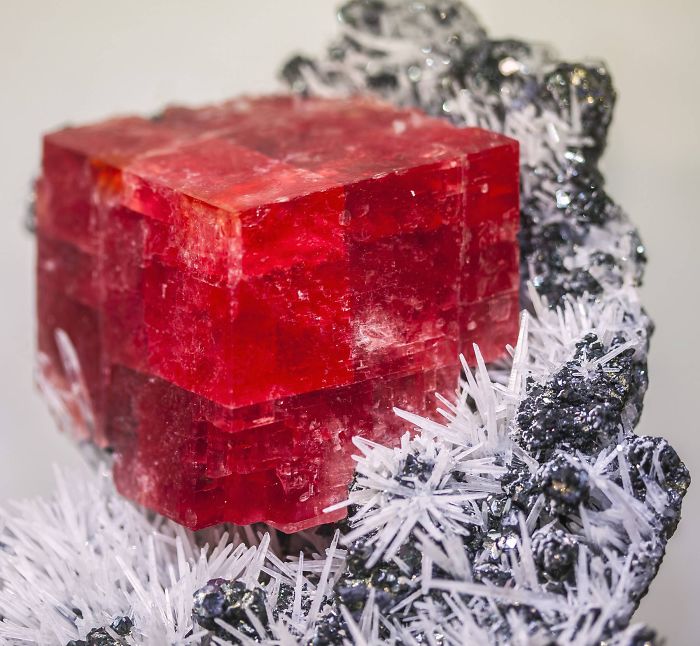
Stibnite
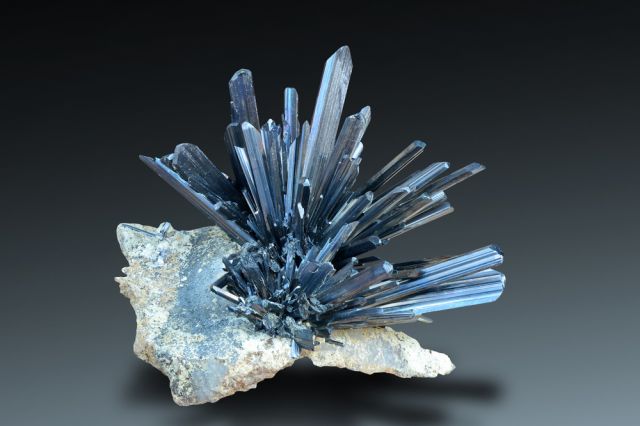
The most complex crystal ever created.
The icosahedron. And we have such understanding of how they grow, that we can write software that,
given the right chemical properties, will self-assemble into this most extraordinary structure.

Crystals grow due to a ripening effect, as described by 2 different lines of research.
Ostwald Ripening
Yea, we are moving fast here, but more details blur the big picture. The complexity of crystal
growth is fascinating. We can also verify that our DNA, is a crystal as well.
We also know that crystal formation is a fundamental process in our universe, as we
have examples of just about every type of crystal groups found in meteorites.
These next 2 slides show crystal growth in meteorites.
A pallasite (Esquel) Showing the growth of Olivine (Peridot) crystals withing an Nickel / Iron matrix.
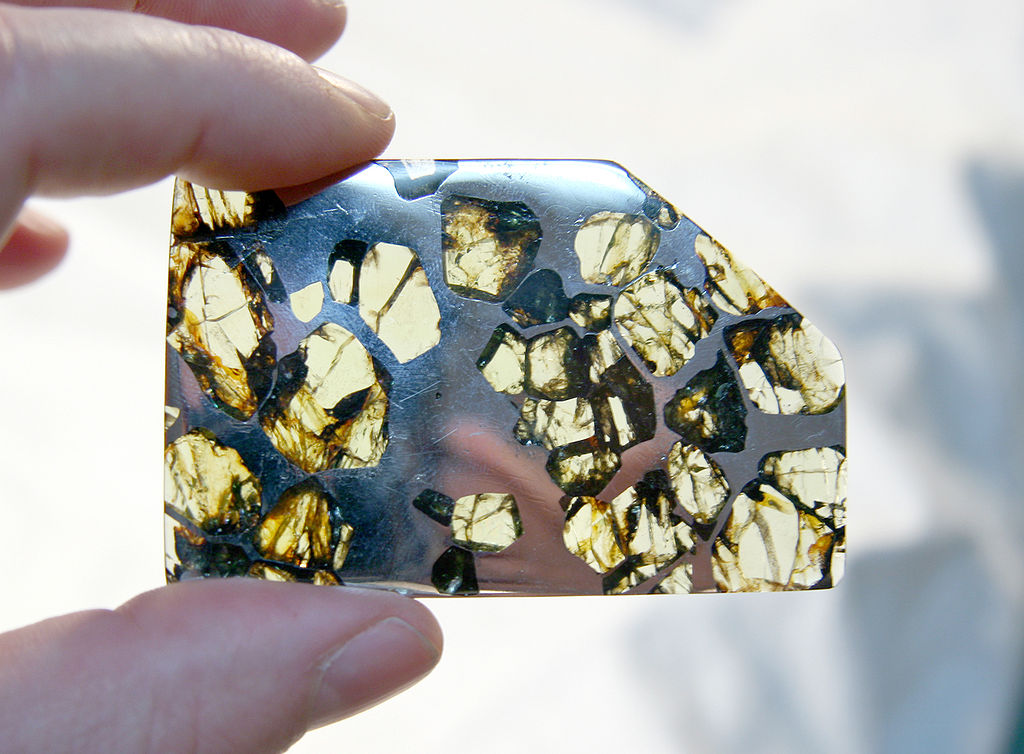
Cross section thin-slice of a chondritic meteorite, showing Chondrules, Olivine and
feldspar crystals.
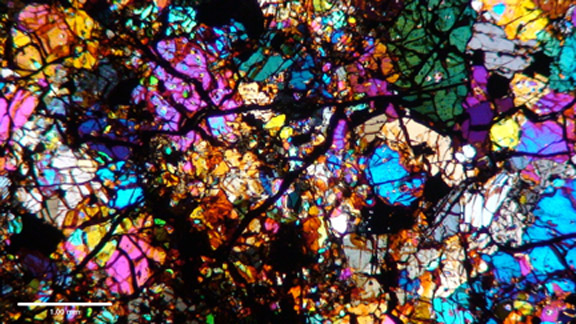
Sourceigg
DNA Liquid Crystals
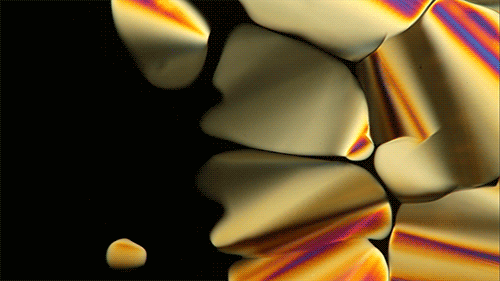
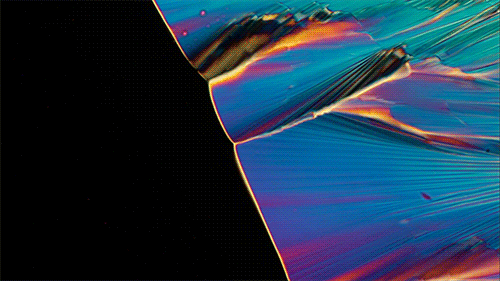
Taking it further, how crystals form, how life evolves, are intimately related. We
still do not have an answer on the possibilities of intelligent design, but how far
back do we have to go to prove it one way or another.... Most likely an infinite
regression.
Water, the essence of life. There are no 2 crystals of frozen water that are exactly
alike. Need we say more? We ourselves, are 55-65% water.

The memory of water
We may be nothing more than a complex assemblage of advanced crystals,
and that would mean that life is most likely everywhere, on the same evolutionary path.
In essence, postulation that there is an intelligent mechanism that is behind everything we see and experience.
As such, it is peering into the eye of God, for what ever God really is.
Not in a religious sense, but more importantly in understanding the
incredible granularity that exists in more fundamental processes that relate to the
formation of life as we understand it.
If we step back and look at what nature has created, in order for life to even start,
we need look no further than crystals.
The fundamental structures of atoms and molecules themselves, show incredible intent as
well as evolution..

This is a molecule of sodium chloride. Like it's primitive state, salt crystals (and
all crystals) mimic this initial state in all of the geometry that follows in it's growth.
Credit to: By Benjah-bmm27 for the model.
Without going into great detail, you get the idea. Crystals grow into some
extraordinary designs and complexity, based solely on how they appear in their
atomic/molecular state.
Prime examples in geology:
Rhodochrosite

Stibnite

The most complex crystal ever created.
The icosahedron. And we have such understanding of how they grow, that we can write software that,
given the right chemical properties, will self-assemble into this most extraordinary structure.

While icosahedral symmetry is relatively common in nature (especially in viruses) and IQCs
can be found in many metal alloys, the question that surrounds them, as posed by the University of Michigan
study is “how do atoms (or other elementary building blocks) arrange themselves rapidly, and with
near structural perfection, into a long-range ordered configuration without the guidance of a unit cell?”
Crystals grow due to a ripening effect, as described by 2 different lines of research.
J. Michael McBride, Ph.D. is one who studies crystals and crystal growth. Dr. McBride
and his group are currently researching on the Viedma ripening and using optical and atomic
force microscopy to study aspects of crystal nucleation, growth, and dissolution to elucidate
the mechanisms of Viedma ripening.
Ostwald ripening is an observed phenomenon in solid solutions or liquid sols that describes
the change of an inhomogeneous structure over time, i.e., small crystals or sol particles dissolve,
and redeposit onto larger crystals or sol particles.
An everyday example of Ostwald ripening is the re-crystallization of water within ice cream
which gives old ice cream a gritty, crunchy texture. Larger ice crystals grow at the expense of
smaller ones within the ice cream, creating a coarser texture.
Another gastronomical example is in the ouzo effect, where the droplets in the cloudy microemulsion
grow by Ostwald ripening. In geology, it is the textural coarsening, aging or growth of phenocrysts
and crystals in solid rock which is below the solidus temperature.
Ostwald Ripening
Yea, we are moving fast here, but more details blur the big picture. The complexity of crystal
growth is fascinating. We can also verify that our DNA, is a crystal as well.
We also know that crystal formation is a fundamental process in our universe, as we
have examples of just about every type of crystal groups found in meteorites.
These next 2 slides show crystal growth in meteorites.
A pallasite (Esquel) Showing the growth of Olivine (Peridot) crystals withing an Nickel / Iron matrix.

Cross section thin-slice of a chondritic meteorite, showing Chondrules, Olivine and
feldspar crystals.

These next fascinating images, that on first inspection look like a Grateful Dead gatefold, are actually liquid DNA molecules crystallizing. They were captured by the artist and biochemist Linden Gledhill for a new project called MSSNG.
Sourceigg
DNA Liquid Crystals


Taking it further, how crystals form, how life evolves, are intimately related. We
still do not have an answer on the possibilities of intelligent design, but how far
back do we have to go to prove it one way or another.... Most likely an infinite
regression.
Water, the essence of life. There are no 2 crystals of frozen water that are exactly
alike. Need we say more? We ourselves, are 55-65% water.

The memory of water
We may be nothing more than a complex assemblage of advanced crystals,
and that would mean that life is most likely everywhere, on the same evolutionary path.
edit on 23-7-2016 by charlyv because: spelling , where caught
edit on 23-7-2016 by charlyv because: (no reason
given)
edit on 23-7-2016 by charlyv because: spelling , where caught
edit on 23-7-2016 by charlyv because: spelling ,
where caught
edit on 23-7-2016 by charlyv because: fix links
edit on 23-7-2016 by charlyv because: (no reason
given)
originally posted by: charlyv
Are we all really advanced crystal beings?
In essence, postulation that there is an intelligent mechanism that is behind everything we see and experience.
As such, it is peering into the eye of God, for what ever God really is.
Not in a religious sense, but more importantly in understanding the
incredible granularity that exists in more fundamental processes that relate to the
formation of life as we understand it.
If we step back and look at what nature has created, in order for life to even start,
we need look no further than crystals.
If you knew how close you were to one of the greatest alchemic secrets of humaniies history you would stop drop and roll....carry on fine soul...carry on....let the Ganesh particle light your path,let the spark of life that which is within and without be the catalyst of your journey.Lobsang...well done.
The fundamental structures of atoms and molecules themselves, show incredible intent as
well as evolution..
This is a molecule of sodium chloride. Like it's primitive state, salt crystals (and
all crystals) mimic this initial state in all of the geometry that follows in it's growth.
Credit to: By Benjah-bmm27 for the model.
Without going into great detail, you get the idea. Crystals grow into some
extraordinary designs and complexity, based solely on how they appear in their
atomic/molecular state.
Prime examples in geology:
Rhodochrosite
Stibnite
The most complex crystal ever created.
The icosahedron. And we have such understanding of how they grow, that we can write software that,
given the right chemical properties, will self-assemble into this most extraordinary structure.
While icosahedral symmetry is relatively common in nature (especially in viruses) and IQCs
can be found in many metal alloys, the question that surrounds them, as posed by the University of Michigan
study is “how do atoms (or other elementary building blocks) arrange themselves rapidly, and with
near structural perfection, into a long-range ordered configuration without the guidance of a unit cell?”
Crystals grow due to a ripening effect, as described by 2 different lines of research.
J. Michael McBride, Ph.D. is one who studies crystals and crystal growth. Dr. McBride
and his group are currently researching on the Viedma ripening and using optical and atomic
force microscopy to study aspects of crystal nucleation, growth, and dissolution to elucidate
the mechanisms of Viedma ripening.
Ostwald ripening is an observed phenomenon in solid solutions or liquid sols that describes
the change of an inhomogeneous structure over time, i.e., small crystals or sol particles dissolve,
and redeposit onto larger crystals or sol particles.
An everyday example of Ostwald ripening is the re-crystallization of water within ice cream
which gives old ice cream a gritty, crunchy texture. Larger ice crystals grow at the expense of
smaller ones within the ice cream, creating a coarser texture.
Another gastronomical example is in the ouzo effect, where the droplets in the cloudy microemulsion
grow by Ostwald ripening. In geology, it is the textural coarsening, aging or growth of phenocrysts
and crystals in solid rock which is below the solidus temperature.
Ostwald ripening
Yea, we are moving fast here, but more details blur the big picture. The complexity of
crystal growth is fascinating. We can also verify that our DNA, is a crystal as well.
We also know that crystal formation is a fundamental process in our universe, as we
have examples of just about every type of crystal groups found in meteorites.
These next 2 slides show crystal growth in meteorites.
A pallasite (Esquel) Showing the growth of Olivine (Peridot) crystals withing an Nickel
Iron matrix.
Cross section thin-slice of a chondritic meteorite, showing Chondrules, Olivine and
feldspar crystals.
These next fascinating images, that on first inspection look like a Grateful Dead gatefold, are actually liquid DNA molecules crystallizing. They were captured by the artist and biochemist Linden Gledhill for a new project called MSSNG.
Sourceigg
DNA Liquid Crystals
Taking it further, how crystals form, how life evolves, are intimately related. We
still do not have an answer on the possibilities of intelligent design, but how far
back do we have to go to prove it one way or another.... Most likely an infinite
regression.
Water, the essence of life. There are no 2 crystals of frozen water that are exactly
alike. Need we say more? We ourselves, are 55-65% water.
The memory of water
We may be nothing more than a complex assemblage of advanced crystals,
and that would mean that life is most likely everywhere, on the same evolutionary path.
I love the way they 'represent' the structure of minute bits of matter that we can't see as 'balls' all grouped together linearly.
The nucleus of an atom is a bunch of little spheres all stuck together? Or a single object with a north and south pole?
Just can't get that image out of my mind. A star is a singular object, so is a planet or moon.
But atoms are tiny clusters of little spheres, huh?
The nucleus of an atom is a bunch of little spheres all stuck together? Or a single object with a north and south pole?
Just can't get that image out of my mind. A star is a singular object, so is a planet or moon.
But atoms are tiny clusters of little spheres, huh?
edit on 23-7-2016 by intrptr because: spelling
a reply to: charlyv this is one of the most exciting discoveries yet. I just flipped to my book on crystals and stones to look
up, Rhodachrosite...I believe I had this at one time
Thanks for this, OP...will now study more on just the first stone mentioned.
Thanks for this, OP...will now study more on just the first stone mentioned.
edit on 23-7-2016 by peppycat because: tablet issue
originally posted by: intrptr
I love the way they 'represent' the structure of minute bits of matter that we can't see as 'balls' all grouped together linearly.
The nucleus of an atom is a bunch of little spheres all stuck together? Or a single object with a north and south pole?
Just can't get that image out of my mind. A star is a singular object, so is a planet or moon.
But atoms are tiny clusters of little spheres, huh?
So you have problems understanding the meaning of the word "representation" aka model?
a reply to: intrptr
because that is what they are
basically yes
Well no, those objects are made up of the very things you question exist. In ENORMOUS AMOUNTS.
Atoms are weird little things in general. They like some things and not others, they get together sometimes but sometimes they fight, they always follow a rule, they seem unimportant but understanding them really is important in human physiology.
Just so you know, you have never actually touched anything. It was the chemical/electrical intervention between your hand molecules and the other things molecules every single time.
I love the way they 'represent' the structure of minute bits of matter that we can't see as 'balls' all grouped together linearly
because that is what they are
The nucleus of an atom is a bunch of little spheres all stuck together? Or a single object with a north and south pole?
basically yes
A star is a singular object, so is a planet or moon.
Well no, those objects are made up of the very things you question exist. In ENORMOUS AMOUNTS.
But atoms are tiny clusters of little spheres, huh?
Atoms are weird little things in general. They like some things and not others, they get together sometimes but sometimes they fight, they always follow a rule, they seem unimportant but understanding them really is important in human physiology.
Just so you know, you have never actually touched anything. It was the chemical/electrical intervention between your hand molecules and the other things molecules every single time.
a reply to: Vector99
Yes I know. Atoms are mostly empty space, little nothings whizzing about. So are stars and their solar systems, just on a different scale.
As above, so below.
Edit: There, i just explained the Grand Unified Theory for everyone.
Just so you know, you have never actually touched anything. It was the chemical/electrical intervention between your hand molecules and the other things molecules every single time.
Yes I know. Atoms are mostly empty space, little nothings whizzing about. So are stars and their solar systems, just on a different scale.
As above, so below.
Edit: There, i just explained the Grand Unified Theory for everyone.
edit on 23-7-2016 by intrptr because: link
originally posted by: intrptr
a reply to: Vector99
Just so you know, you have never actually touched anything. It was the chemical/electrical intervention between your hand molecules and the other things molecules every single time.
Yes I know. Atoms are mostly empty space, little nothings whizzing about. So are stars and their solar systems, just on a different scale.
As above, so below.
Their true physical form has to be put through extensive filtering for us to observe them with today's instruments.
Their true nature is on the quantum level, only visible through quantum eyes.
originally posted by: charlyv
originally posted by: intrptr
a reply to: Vector99
Just so you know, you have never actually touched anything. It was the chemical/electrical intervention between your hand molecules and the other things molecules every single time.
Yes I know. Atoms are mostly empty space, little nothings whizzing about. So are stars and their solar systems, just on a different scale.
As above, so below.
Their true physical form has to be put through extensive filtering for us to observe them with today's instruments.
Their true nature is on the quantum level, only visible through quantum eyes.
Ever see Mulholland Falls with Nick Nolte? He questions a physicist that describes the nature of atoms.
If we could stand on an electron orbiting a nucleus the next atom would appear as far away as the next star does in the night sky.
Or some such.
originally posted by: intrptr
originally posted by: charlyv
originally posted by: intrptr
a reply to: Vector99
Just so you know, you have never actually touched anything. It was the chemical/electrical intervention between your hand molecules and the other things molecules every single time.
Yes I know. Atoms are mostly empty space, little nothings whizzing about. So are stars and their solar systems, just on a different scale.
As above, so below.
Their true physical form has to be put through extensive filtering for us to observe them with today's instruments.
Their true nature is on the quantum level, only visible through quantum eyes.
Ever see Mulholland Falls with Nick Nolte? He questions a physicist that describes the nature of atoms.
If we could stand on an electron orbiting a nucleus the next atom would appear as far away as the next star does in the night sky.
Or some such.
Yes, and you were leading on the same premise. If it is a scalar phenomena, then the stars in our neighborhood could have interaction with our environment that we have not been able to quantify, but most likely exist.
edit on 23-7-2016 by charlyv because: reply typo
a reply to: intrptr
a reply to: charlyv
I think about this all the time. Excellent thread just for this little back and forth alone.
a reply to: charlyv
originally posted by: charlyv
Yes, and you were leading on the same premise. If it is a scalar phenomena, then the stars in our neighborhood could have interaction with our environment that we have not been able to quantify, but most likely exist.
I think about this all the time. Excellent thread just for this little back and forth alone.
As a further contribution to this, it should be emphasized that replication is the fundamental of evolution.
Crystals replicate onto their surfaces, however DNA replication (crystallization) requires RNA, another crystal if you will,
and produces long chains. One would wonder if DNA is in itself, the final evolution of the crystal as the enabler of life.
Crystals replicate onto their surfaces, however DNA replication (crystallization) requires RNA, another crystal if you will,
and produces long chains. One would wonder if DNA is in itself, the final evolution of the crystal as the enabler of life.
originally posted by: charlyv
originally posted by: intrptr
originally posted by: charlyv
originally posted by: intrptr
a reply to: Vector99
Just so you know, you have never actually touched anything. It was the chemical/electrical intervention between your hand molecules and the other things molecules every single time.
Yes I know. Atoms are mostly empty space, little nothings whizzing about. So are stars and their solar systems, just on a different scale.
As above, so below.
Their true physical form has to be put through extensive filtering for us to observe them with today's instruments.
Their true nature is on the quantum level, only visible through quantum eyes.
Ever see Mulholland Falls with Nick Nolte? He questions a physicist that describes the nature of atoms.
If we could stand on an electron orbiting a nucleus the next atom would appear as far away as the next star does in the night sky.
Or some such.
Yes, and you were leading on the same premise. If it is a scalar phenomena, then the stars in our neighborhood could have interaction with our environment that we have not been able to quantify, but most likely exist.
Iv'e wondered about that. Stars revolving in a galaxy seem to stay 'spaced', just like dust suspended in an air column, or rain drops, snowflakes. That denotes ether of some sort. The ether of gravity, or something else?
originally posted by: charlyv
As a further contribution to this, it should be emphasized that replication is the fundamental of evolution.
Crystals replicate onto their surfaces, however DNA replication (crystallization) requires RNA, another crystal if you will,
and produces long chains. One would wonder if DNA is in itself, the final evolution of the crystal as the enabler of life.
Life from lifelessness? Life is different from matter, imo.
originally posted by: Vector99
a reply to: intrptr
It is atoms that make up everything though.
We actually have observed them.
They've discovered smaller stuff, when smashing atoms. Love the diagrams that show things 'spiraling' back to their orbits.
Not unlike diagrams of the solar system.
image search
new topics
-
StormyD Accused of Falsification of Business Records to Hide Money From Trump
US Political Madness: 39 minutes ago -
Judge Postpones Trump Classified Docs Trial INDEFINITELY
US Political Madness: 2 hours ago -
To all ATS members of Faith - Prayer request
Religion, Faith, And Theology: 6 hours ago -
Don’t Obstruct the Leftist Implosion
US Political Madness: 6 hours ago -
NASA Black Hole Visualization - Go Beyond the Brink
Space Exploration: 7 hours ago -
Russia police launch major manhunt after troops massacred by comrade in occupied Ukraine
Other Current Events: 10 hours ago -
Chinese scientists create new mutant Ebola strain with horror eye symptoms
Breaking Alternative News: 11 hours ago -
Maclemore - Hind's Hall (Pro-Palestine protest song)
Music: 11 hours ago
top topics
-
Don’t Obstruct the Leftist Implosion
US Political Madness: 6 hours ago, 23 flags -
Judge Postpones Trump Classified Docs Trial INDEFINITELY
US Political Madness: 2 hours ago, 21 flags -
Trump supporters training in the HILLS!!!!
US Political Madness: 13 hours ago, 16 flags -
To all ATS members of Faith - Prayer request
Religion, Faith, And Theology: 6 hours ago, 12 flags -
Chinese scientists create new mutant Ebola strain with horror eye symptoms
Breaking Alternative News: 11 hours ago, 10 flags -
Black kids in the Bronx don't know what the word 'computer' is
People: 17 hours ago, 8 flags -
StormyD Accused of Falsification of Business Records to Hide Money From Trump
US Political Madness: 39 minutes ago, 7 flags -
Russia police launch major manhunt after troops massacred by comrade in occupied Ukraine
Other Current Events: 10 hours ago, 6 flags -
Social Security projected to cut benefits in 2035 barring a fix
Global Meltdown: 12 hours ago, 6 flags -
NASA Black Hole Visualization - Go Beyond the Brink
Space Exploration: 7 hours ago, 4 flags
active topics
-
What do you guys think of this UFO footage?
Aliens and UFOs • 14 • : EduardoLopez -
StormyD Accused of Falsification of Business Records to Hide Money From Trump
US Political Madness • 6 • : JadedGhost -
We are screwed
Global Meltdown • 21 • : ChaoticOrder -
Medvedev: “No one can hide, a global catastrophe is coming”
World War Three • 258 • : Freeborn -
To all ATS members of Faith - Prayer request
Religion, Faith, And Theology • 21 • : ntech620 -
Israel rejected early Hamas offer to free all civilians if IDF didn’t enter Gaza
Middle East Issues • 197 • : xuenchen -
Breaking--Hamas Accepts New Cease Fire
Middle East Issues • 248 • : xuenchen -
SETI chief says US has no evidence for alien technology. 'And we never have'
Aliens and UFOs • 90 • : EduardoLopez -
Israeli strikes on southern Gaza city of Rafah kill 22, mostly children, as US advances aid package
Middle East Issues • 175 • : KrustyKrab -
Chinese scientists create new mutant Ebola strain with horror eye symptoms
Breaking Alternative News • 20 • : ntech620
